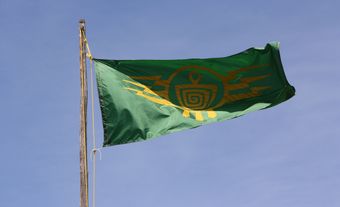Fort Saskatchewan, Alberta, incorporated as a city in 1985, population 24,149 (2016 census), 19,051 (2011 census). The city of Fort Saskatchewan is located northeast of Edmonton, on the prairie parklands along to the North Saskatchewan River.
Indigenous Peoples
Indigenous peoples have lived in the Fort Saskatchewan area for thousands of years. Fort Saskatchewan is part of Treaty 6. Treaty 6 is an agreement made between the Crown and Cree, Assiniboine and Ojibwe leaders in 1876. Today, 6 per cent of Fort Saskatchewan’s population identifies as Indigenous, according to the 2016 census. Four per cent are Métis, and the remaining 2 per cent First Nations and Inuit.
European Settlement and Development
As early as the 1790s, the fur trade flowed through the region. In 1872, pioneering French Canadians began farming in the area. However, the community really started with the establishment of a North-West Mounted Police post in 1875. Inspector William D. Jarvis led a group of North-West Mounted Police to Fort Edmonton during the force’s “March West” (see Red Coat Trail). However, Jarvis chose Fort Saskatchewan as the location for the post over Fort Edmonton. The banks of the North Saskatchewan River were gentler at Fort Saskatchewan and therefore better for a future railway crossing. It was also chosen in order to avoid Hudson’s Bay Company lands. Although the fort was originally known as Sturgeon Creek Post, it was later renamed Fort Saskatchewan.
During the 1880s, extensive surveying took place for both the expanding urban settlement and surrounding river-lot farmlands. A year after Fort Saskatchewan was incorporated as a town (1904), the Canadian National Railway line reached the town and built the bridge Jarvis had envisaged years earlier. The town remained a small rural farming centre until after the Second World War.
Economy
In 1954, Sherritt Gordon Mines Ltd. (now Sherritt International Corp.) completed a multimillion-dollar nickel refinery. The refinery was Fort Saskatchewan’s first major industry. Over the succeeding years, Fort Saskatchewan experienced steady growth with petrochemical industries moving into the area. In 1966, Sherritt began producing coins and medallions, which later included the blank for the Canadian $1 coin (the “loonie”). The company has since sold its interest in this coinage operation.
Major manufacturing companies that operate in Fort Saskatchewan today include Dow Canada, Praxair Canada and Nutrien. Today, these industries, a provincial jail — here since 1914 — and a thriving service component support one of Alberta’s oldest settlements.

 Share on Facebook
Share on Facebook Share on X
Share on X Share by Email
Share by Email Share on Google Classroom
Share on Google Classroom



